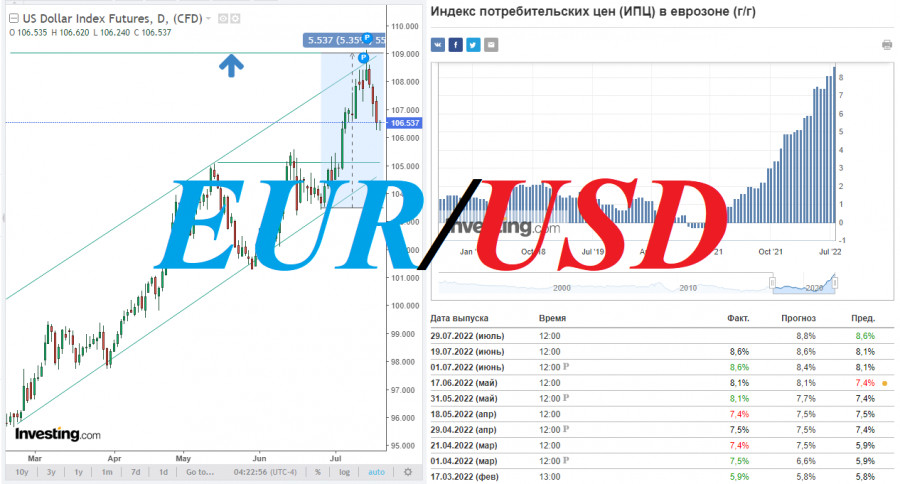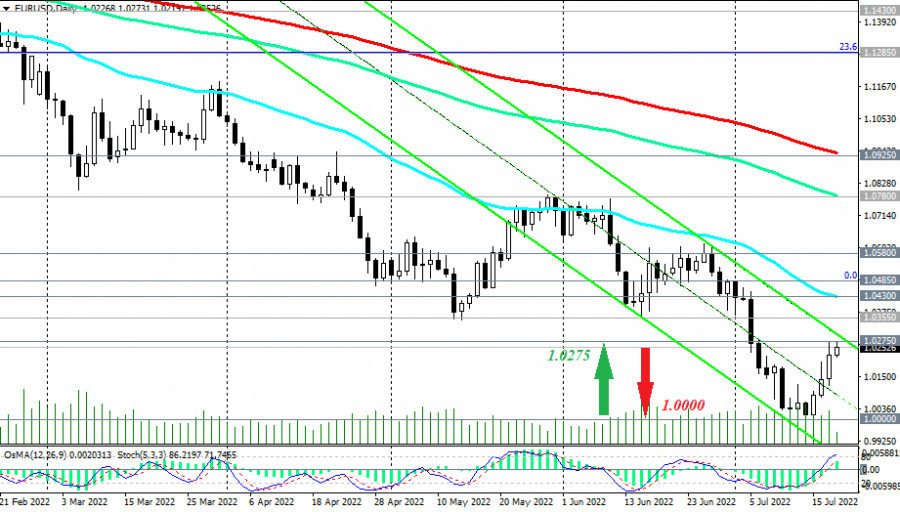At the start of today's European session, dollar index (DXY) futures are trading at today's open and yesterday's close, remaining in a tight range around 106.54. Traders have so far avoided opening large deals on the eve of tomorrow's ECB meeting, hoping to see and catch strong movements in the market tomorrow, while the EUR/USD pair is trading in a narrow range near yesterday's high and the local resistance level of 1.0275.
It is expected that following the results of tomorrow's meeting, the ECB will raise its interest rates by 0.25% for the first time in 11 years. But there is also an opinion that the bank's management will go for a more decisive tightening of monetary policy in the face of accelerating inflation, which reached 8.6% year-on-year in June. There is a forecast that the ECB will raise its interest rates by 0.50% and may announce further increases at the next meetings. Since the share of the European currency in international settlements, although it sharply decreased in March 2022 amid geopolitical uncertainty and rising inflation, amounting to 35.4%, according to SWIFT, it ranks second after the US dollar (the dollar's share in international settlements jumped in March to 41.1%, the highest since April 2020).
It means that tomorrow's meeting of the ECB may have, though not fateful, but impressive impact not only on the euro, but also on the dynamics of the entire financial market, especially if the ECB management manages to surprise the markets with its unexpected decisions or statements.

As follows from yesterday's Eurostat report, annual inflation in the Eurozone in June amounted to 8.6% (final estimate), which is in line with forecasts. Meanwhile, the European Commission faces a difficult situation of the possibility that the Nord Stream 1 gas pipeline will not be launched after the completion of scheduled maintenance. Earlier, Gazprom has already stated that it will not be able to guarantee the resumption of the gas pipeline due to force majeure. This threatens a new round of growth in gas prices for Europe and another jump in inflation. The IMF has already said that the European economy will suffer great economic damage from the Russian gas embargo, and the energy crisis puts the ECB in a difficult position in formulating policy.
In addition, the euro is under pressure from the uncertain political situation in Italy that has arisen around the possible resignation of Mario Draghi from the post of prime minister: early elections may take place in Italy, and it remains to be seen which political forces will come to power—centrifugal or centripetal in relation to Italy's stay in European Union and Eurozone.
As for the US dollar and the DXY index, given the strong bullish momentum and the long-term DXY upward trend, the breakdown of the local resistance level of 109.00 will be a signal to increase long positions in DXY futures with the prospect of growth towards multi-year highs of 121.29 and 129.05, reached, respectively, in June 2001 and in November 1985.
Summary: There is every reason to believe that EUR/USD will test the strength of the 1.0000 level again, especially if tomorrow's ECB decision on its monetary policy disappoints market participants. A press conference following the ECB meeting will also be of great importance, during which a surge in volatility is possible, not only in euro quotes, but also in the entire financial market. In previous years, following the results of some ECB meetings and subsequent press conferences, the euro exchange rate changed by 3%–5% in a short time. If market participants regard the tone of the statements as soft, then this will have a negative impact on the euro, which may move much below parity with the dollar.
In an alternative scenario, EUR/USD will break through the local resistance level of 1.0275 and rapidly head upward. But here, too, the pair needs to break through the resistance levels of 1.0430, 1.0485 to continue growing towards the key resistance levels of 1.0780, 1.0925.
The decision of the ECB on rates will be published tomorrow at 12:15 GMT.











